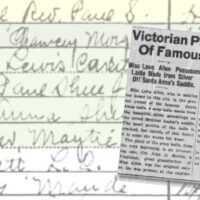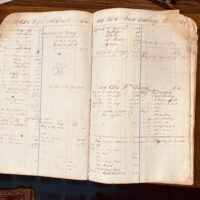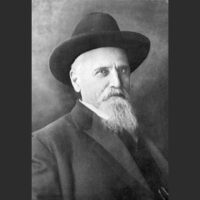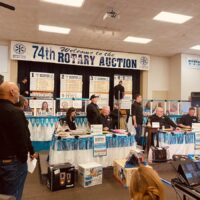This is the second installment in a four-part Black History Month series. This week’s feature looks at the military service of 10 men from Christian County who enlisted in the U.S. Navy during the Civil War.
On July 2, 1864, Peter Beseley, a 40-year-old Black man who said he came from Christian County, Kentucky, joined the United States Navy. It appears he enlisted at Johnsonville, Tennessee. He said he was a farmer, according to military records that went virtually unstudied until a couple of decades ago when Howard University led a research project with the Department of the Navy and the National Park Service to explore the contributions of Black Union sailors during the Civil War.
Beseley is one among roughly 18,000 Black men who served in the U.S. Navy during the Civil War, the Black Sailors Research Project determined. There were a little more than 400 Kentuckians in the group. At least 10 were from Christian County — and of those Beseley was the oldest.
But Beseley’s entry illustrates a common thread that runs through the stories of all of these Black sailors. Each entry for a sailor of African descent provides a few biographical details, a military rank, which ships they served on, and how long they remained in service. It is not an easy task to learn more about each man’s life before the war, how they fared in the Navy, and what became of them after the war. The scarcity of public records and newspaper accounts for Black Americans is true for those in all walks of life, whether they served in the military or worked as tradesmen, sharecroppers, midwives or laborers.

For example, I suspected that Beseley was not the correct spelling of this sailor’s last name. And then I found a hospital record that appears to confirm my suspicion. There is a Peter Beasley, who was born in Christian County and spent time in a Memphis hospital in November 1864. He was being treated for “chronic rheumatism,” according to a naval hospital log.
This is very likely the man listed as Peter Beseley on enlistment papers. But I have more questions. Had he been enslaved prior to enlistment? Did he escape his enslaver? Was he married? Did he have children?
Many of my questions also apply to the other nine men who listed Hopkinsville or Christian County as their home.
None of the sailors from Christian County was listed as being a slave at the time of enlistment. I wondered if some chose not to reveal that they had escaped slavery so they could join. And I wonder what each of them was doing after the war.
Here are details about each man:
Peter Beseley (Beasley), of Christian County, was 40 years old when he enlisted on July 2, 1864, somewhere on the Tennessee River. He was 5-foot-7 and listed his occupation as farmer. His navy rank was landsman. He served two years with time on the USS Pinkney and USS Tawah.
Anderson Bradshaw, of Hopkinsville, was 17 when he enlisted on Dec. 16, 1863, at Clarksville, Tennessee. He was 5-foot-4 and had the rank of first class boy. He served one year and was assigned to the USS Silver Lake.
Samuel Bradshaw, of Christian County, enlisted at age 27 on Aug. 2, 1864, at Clarksville. He was a waiter in civilian life and stood 5-foot-4. The navy gave him the job of coal heaver, so his muscle was responsible for powering steam engines. Bradshaw served on the Suwanee, Vanderbilt and Antona. He was in the Navy for three years.
James Burke, of Christian County, was 29 when he enlisted on Jan. 9, 1863. He was taller than most enlistees at 5-foot-10. He listed his occupation as a bricklayer. He served in the navy for one year as a fireman. He served on the USS Linden.
Jesse Ellis was 14 years old and stood 4-foot-10 when he enlisted on Jan. 25, 1864, at Clarksville. He served one year with the rank of first class boy on the USS Moose.
Also enlisting on Jan. 25, 1864, at Clarksville and assigned to the USS Moose was Gringo Livell, of Christian County. He was a 25-year-old farmer and stood 5-foot-8. His rank was landsman. He served one year.
Samuel Hubbard, of Hopkinsville, was 18 and listed his occupation as farmer when he enlisted on Feb. 8, 1864, at Clarksville. He joined Ellis and Livell aboard the Moose and had the rank of seaman. He was 5-foot-4. He served one year.
John Marshall, of LaFayette, was 35 when he enlisted on Oct. 1, 1862, at Helena, Arkansas. He was 5-foot-8. His rank was first class boy, and he served two years on the USS Benton.
Andrew Minter, of Hopkinsville, enlisted on May 13, 1863. He was 26 and stood 5-foot-8. His navy rank was fireman. He was assigned to the USS Kenwood and served two years.
Willis Ware, of Christian County, enlisted at age 23 on Dec. 27, 1864, at Cairo, Illinois, and served for two years. He was 5-foot-8. The navy gave him the rank of landsman, and he served on the USS Silver Cloud.
If any Hoptown Chronicle readers believe they are related to one of the sailors, or you have more information about one or more of the men, we would like to hear from you.
I also looked into some of the Navy vessels listed on the military records for the 10 Black sailors from Christian County. Those include:
USS Moose
The tin-clad USS Moose was a sternwheeler that patrolled the Mississippi, Cumberland and Tennessee rivers. On April 16, 1864, the gunboat broke up a Confederate attack at Columbus in far Western Kentucky. The Moose patrolled from May to December 1864 on the Cumberland River at Nashville to thwart Confederate guerrilla attacks. Renamed the SS Little Rock after the war, it was destroyed by fire on Dec. 23, 1867.
USS Tawah
A 108-ton, tin-clad wooden steamer, the USS Tawah was part of the Mississippi Squadron and patrolled the Tennessee River. One steam engine and two sidewheels powered the vessel. After its artillery weapons were disabled and the ship was damaged by Confederates firing from the shore, the Union forces abandoned Tawah and destroyed it so the Confederates couldn’t take control of it.
USS Benton
A 1,033-ton gunboat, the USS Benton was an iron-clad vessel. It was converted from a snag boat that cleared trees and other obstructions on the Mississippi River. After the war it was decommissioned, sold for $3,000 and was scrapped.
USS Linden
A wooden sidewheel steamer, the USS Linden was a support vessel in the Siege of Vicksburg in May 1863, a crucial victory that gave the Union control of the Mississippi River. The Linden hit a snag on the Arkansas River on Feb. 22, 1864, and sank.
USS Kenwood
A sternwheel steamer, the USS Kenwood was involved in the capture of Yahoo City, Mississippi, in July 1863 and then served as a patrol gunboat at Baton Rouge. In May 1865 it became a transport vessel for officers in New Orleans.
USS Silver Lake
The USS Silver Lake was a tin-clad, sternwheel steamer. Thirty miles south of Hopkinsville on the Cumberland River, the Silver Lake and four other Union vessels attacked Confederate guerrilla forces in early April 1863. Silver Lake was auctioned after the war. It was altered with the addition of side wheels and renamed Mary Hein. Fire destroyed the steamer on Feb. 27, 1866.
USS Silver Cloud
Also a tin-clad sternwheel steamer, the USS Silver Cloud patrolled the Tennessee River. Sold after the war for civilian use, it sank on Feb. 27, 1866, in the Buffalo Bayou of Texas.
Jennifer P. Brown is co-founder, publisher and editor of Hoptown Chronicle. You can reach her at editor@hoptownchronicle.org. She spent 30 years as a reporter and editor at the Kentucky New Era. She is a co-chair of the national advisory board to the Institute for Rural Journalism and Community Issues, governing board president for the Kentucky Historical Society, and co-founder of the Kentucky Open Government Coalition.





